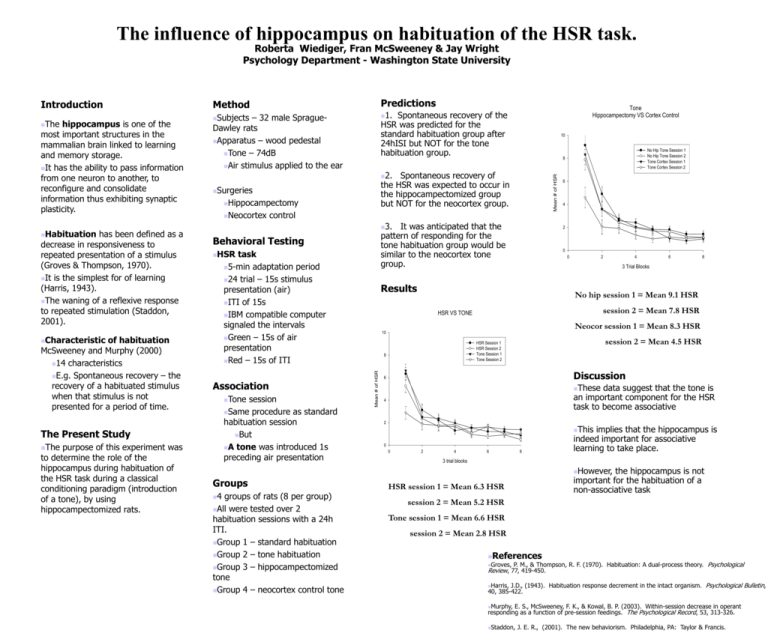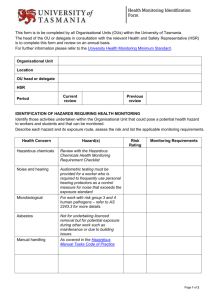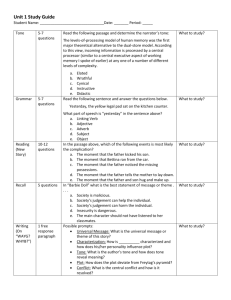A tone - Washington State University
advertisement

The influence of hippocampus on habituation of the HSR task. Roberta Wiediger, Fran McSweeney & Jay Wright Psychology Department - Washington State University hippocampus is one of the most important structures in the mammalian brain linked to learning and memory storage. It has the ability to pass information from one neuron to another, to reconfigure and consolidate information thus exhibiting synaptic plasticity. Habituation has been defined as a decrease in responsiveness to repeated presentation of a stimulus (Groves & Thompson, 1970). It is the simplest for of learning (Harris, 1943). The waning of a reflexive response to repeated stimulation (Staddon, 2001). of habituation McSweeney and Murphy (2000) 14 characteristics E.g. Spontaneous recovery – the recovery of a habituated stimulus when that stimulus is not presented for a period of time. Spontaneous recovery of the HSR was predicted for the standard habituation group after 24hISI but NOT for the tone habituation group. – 32 male SpragueDawley rats Apparatus – wood pedestal Tone – 74dB Air stimulus applied to the ear 10 Spontaneous recovery of the HSR was expected to occur in the hippocampectomized group but NOT for the neocortex group. Hippocampectomy control 3. It was anticipated that the pattern of responding for the tone habituation group would be similar to the neocortex tone group. Behavioral Testing HSR task 5-min adaptation period 24 trial – 15s stimulus presentation (air) ITI of 15s IBM compatible computer signaled the intervals Green – 15s of air presentation Red – 15s of ITI Association Tone session Same procedure as standard habituation session But A tone was introduced 1s preceding air presentation The Present Study The No Hip Tone Session 1 No Hip Tone Session 2 Tone Cortex Session 1 Tone Cortex Session 2 8 2. Surgeries Characteristic purpose of this experiment was to determine the role of the hippocampus during habituation of the HSR task during a classical conditioning paradigm (introduction of a tone), by using hippocampectomized rats. 1. Subjects Neocortex Tone Hippocampectomy VS Cortex Control Mean # of HSR The Predictions Method 6 4 2 0 0 2 4 6 8 3 Trial Blocks Results No hip session 1 = Mean 9.1 HSR session 2 = Mean 7.8 HSR HSR VS TONE Neocor session 1 = Mean 8.3 HSR 10 session 2 = Mean 4.5 HSR HSR Session 1 HSR Session 2 Tone Session 1 Tone Session 2 8 Mean # of HSR Introduction Discussion 6 These data suggest that the tone is an important component for the HSR task to become associative 4 2 This 0 0 2 4 6 8 implies that the hippocampus is indeed important for associative learning to take place. 3 trial blocks However, Groups 4 groups of rats (8 per group) All were tested over 2 habituation sessions with a 24h ITI. Group 1 – standard habituation Group 2 – tone habituation Group 3 – hippocampectomized tone Group 4 – neocortex control tone the hippocampus is not important for the habituation of a non-associative task HSR session 1 = Mean 6.3 HSR session 2 = Mean 5.2 HSR Tone session 1 = Mean 6.6 HSR session 2 = Mean 2.8 HSR References P. M., & Thompson, R. F. (1970). Habituation: A dual-process theory. Psychological Review, 77, 419-450. Groves, J.D., (1943). Habituation response decrement in the intact organism. Psychological Bulletin, 40, 385-422. Harris, Murphy, E. S., McSweeney, F. K., & Kowal, B. P. (2003). Within-session decrease in operant responding as a function of pre-session feedings. The Psychological Record, 53, 313-326. Staddon, J. E. R., (2001). The new behaviorism. Philadelphia, PA: Taylor & Francis.





